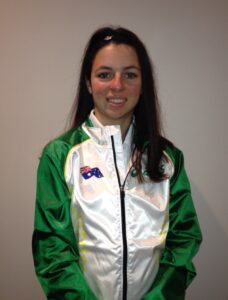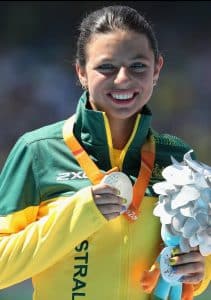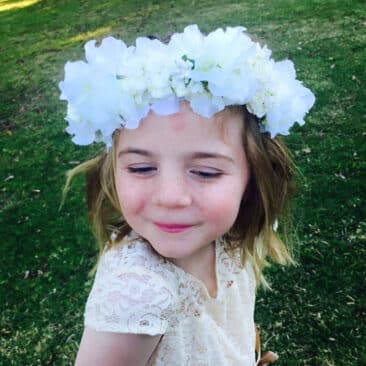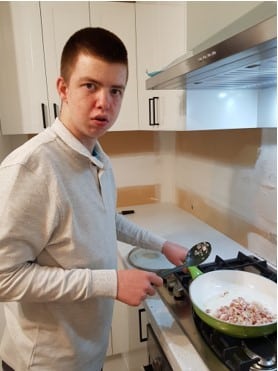Taylor Part 1!
By Shireen, Taylor’s mum (NSW, 2015)

This is a story that can give hope to anybody suffering a serious or debilitating illness or condition.
Taylor was born in 1992 a beautiful first daughter for our family and the first girl on my husband’s side in a very long time. She was born 5 weeks early and came into the world with what we thought was a perfect start to our lives. She was a gorgeous baby and progressed well into her first year of life. Towards the 8 month mark she started to fall behind in her milestones and had what we now know was infantile spasms. Our lives were to change dramatically from that day on.
The early years
Taylor continued to have uncontrolled epilepsy despite numerous medications or combinations of those medications. Due to her severe epilepsy it was decided in consultation with her doctors and family to travel the path of surgery. This was done with much trepidation but also with hope that she may finally be seizure free. So in 1996 Taylor had her surgery, unfortunately with little success. So, we battled on trying to live our life as normally as we could. Taylor went to school in a fantastic setting, we were lucky to get her into a support unit for cerebral palsy where the school teacher, aide and equipment were in abundance. There she thrived and continued to learn despite her difficult seizures. She tried many things and had no fear; she wanted to join in and do many sports because her big brother did. So we enrolled her into dancing, T Ball, swimming, horse-riding really anything that she wanted to do.
The people, coaches, teams, teachers were really fantastic and tried to assist her in anyway. Taylor has a mild moderate intellectual disability and sits closer to the moderate end of the scale so it is often difficult to reason with her when she wants to do things but finds them too difficult. We found that due to her cognitive ability that she had trouble following team instructions and didn’t really fit into team sports. Her memory was poor especially with bad seizure days and often fell behind in the teams, causing her to become frustrated an upset easily.
We can never thank the medical team and allied health professionals enough for all their expertise and the care they have shown us but most of all our thanks go to Taylor for showing us you can achieve anything if you really want it. Taylor, you are amazing.
One day my husband saw an ad for little athletics and thought this might be a good idea as it catered to all ages and you could be a little or a lot involved. So off we went to a try day to give it a go. Well it was amazing Taylor loved it and thought it was just so much fun. Taylor joined the Girraween Club and met some amazing people who took her under their care and looked out for her. She would often start races only to have seizures whilst running down the track often falling over only to pick herself up and continue on, or being at the start of the race to false start due to a seizure nothing fazed her or the staff or other athletes. The most amazing thing for Taylor was that she was good at it, she ran like the wind and was known as the Box Hill bullet (we used to live in that suburb) now she’s known as the Oakville Ostrich (due to a house move).
Taylor has partial complex seizures everyday sometimes 4-6 a day lasting about 1-3minutes in duration and differing in severity. These are just managed by being aware and keeping her safe as sometimes she falls over and can hurt herself. However then we have the darker nasty ones, which cluster; ‘Cluster Seizures’ which are the same seizures though greater in intensity and severity and time. They can go on for many hours the longest cluster for 16 hours whilst in hospital. We intervene with many drugs that being Midazolam, Clobozam and Dilantin at the time and hope it stops quickly but sometimes to no avail and we just have to wait it out. This can happen twice a week for many weeks and then it gives us all a break only to start up again. There is no trigger and it is totally random. We have seen Taylor compete only to be struck by these clusters totally putting her out of action.
Taylor discovers athletics
Taylor continued to develop and grow into a beautiful teenager and started high school in a support unit in a class of 8 students. Luckily it was a school that was interested in her talents and supported her athletics. At the time I was not aware that when schools had athletics or swimming carnivals events were also held for AWDs (Athletes with a Disability) who competed just like everybody else up to the State level. Taylor got the chance to compete and excelled in track and field 100m, 200m and Long Jump, winning many medals along the way. It was here she was introduced to Special Olympics and found a club in Sydney West where she joined and began competing. It was here that she found people of her own abilities intellectual social and competitive. She was given the opportunity of trying many sports and went to her first Junior National Games in Canberra competing in track and field and soccer. She again excelled and won gold and silver in many events. This then progressed over the years to the Senior National Games in Adelaide, again winning many events. These amazing feats led to her being selected for the World Summer Games which were held in Athens, Greece in 2011.

This was fantastic but also very scary for us. She would be away for 3 weeks with the team, away from her parents, away from the people who knew her and her seizures, how she would cope, would it be too much. The day finally came after many presentations and meeting the Governor General and being presented her Australian uniform, there were many family tears I can tell you and we were nervous beyond your imagination. Well she went, coped well, continued to have seizures as we knew they would but she held up and with strength and determination competed and competed well. She brought home two gold and a bronze medal. We were so proud of her and her doctors cannot believe her ability to soldier on. We as a family are still amazed to this day but she continues to strive for excellence.
Taylor continued to compete and moved onto the senior athletics at Girraween, where we competed at many carnivals. We were approached by the coaches and encouraged to let Taylor try some events in the NSW Athletics Club circuit for AWDs. This proved to be very successful for Taylor where she went onto do extremely well at the higher level. Taylor was asked to go the to the Arafura Games held in Darwin where she won a bronze medal in Long Jump from there it only got better. In 2013 Taylor competed in the Athletics Nationals where she won a gold medal in long jump and was crowned the Australian Champion. From here Taylor continued to excel and was given funding from Athletics Australia and has competed in the Global Games in Italy and The World International Paralympic Championships in France.
Tackling Taylor’s epilepsy
Taylor’s seizures continued to be a problem and in February 2014 Taylor went into hospital to undergo a relatively new procedure Stereoelectroencephalography (SEEG). We were doing this to try and stop Taylor’s seizures and give her a better chance in life.
SEEG is an invasive surgical procedure that is used to identify areas of the brain where epileptic seizures originate. During the procedure, doctors place electrodes in targeted brain areas which are then monitored precisely to locate the seizure source. These were implanted and left in place for seven days. Taylor was monitored in hospital, including continuous video recording, electroencephalogram (EEG) and stimulation, all capturing large amounts of data. The doctors then removed these electrodes, again under general anaesthetic, and the team reviewed all the information.
Taylor recovered well and was back to normal activities within the following weeks. Our agonising wait began: will they have enough information, can they do the epilepsy surgery but, most of all, can they locate the origin of her seizures and, if they can, will Taylor be seizure free?
The wait was long and stressful. After about four weeks, news came back that, yes, they could do the surgery. We met with the neurosurgeon who said the focus of her seizures was deep within the brain in her insular cortex. He was confident that he could remove (resect) this area without any complications, although there would be risks as with any surgery. And so we went ahead with it.
On 14 April 2014 (my dad’s birthday – a good sign), we arrived at Westmead Hospital. We had a magnificent team of health professionals on board, and Taylor was made to feel like a celebrity. This put us at ease, as much as we could be. However, a very scary day was ahead of us all. Taylor took it all in her stride and was confident that all would be well.
Off she went in the care of the team and our wait once again began. She went in at 7.00am and came to recovery late in the afternoon. She had come through and once she fully woke up, we went to the intensive care unit (ICU) to spend the next 24 hours prior to going to the neurology ward.
Taylor was awake and talking and drinking. But, over the next few hours we noticed that her condition was changing and she was not right. Her face had changed. The left side of her face was different and the right side of her body was not working. Her doctors were called and she was taken immediately for a scan to see what was happening. The doctors and Taylor returned with ‘good’ news. There was no sign of a stroke or bleed, thank goodness, and that it was more than likely due to swelling. Taylor stayed in ICU for a further 24 hours and then was moved to the neurology ward as she was relatively well. We were terrified but relieved that all would be well within the next few days with steroids to combat the swelling.
However, this was not the case of ‘simple swelling’ that would get better in a few days. The weakness stayed and we became more worried. The neurosurgeon was still very optimistic that all would be okay and that it would just take time to heal. The neurologists were upset that this had happened but were very happy that a week had gone by with no seizures – something we had never experienced before, although it was still early days.
As Taylor hadn’t had a stroke we were not able to access the stroke services such as intensive physiotherapy and occupational therapy. Everyone kept telling us it was important to get intervention to help with the weakness as soon as possible to get a better outcome.
The waiting list for services as an outpatient was six weeks and as an inpatient 2 visits for 15 minutes per service every day was all that was available.

We decided to help Taylor recover by taking her home. And so our internet search for services began. We found a few private services which were extremely expensive as we needed a neuro-physiotherapist (we didn’t even know they existed) and a neuro-occupational therapy. Although they were extremely expensive we decided to go ahead with these important interventions. The therapists came to our house and developed an individual program for Taylor and basically said the more we could do outside of their visits, the quicker things would progress due to the neuroplasticity of the brain.
The fun began (if you can call it that. According to Taylor it wasn’t). Taylor was very frustrated but we persisted every day. We became very adept at getting Taylor to do her exercises and we continued to do this daily for hours on end for many months. Finally, we began to see improvement in her gross motor skills. Her fine motor skills developed more slowly, but at least we were getting there.
Fast forward 2 years … With lots of hard work from Taylor (her determination is incredible), and the rest of her family, Taylor is seizure free and down to a maintenance dose of anticonvulsants. We decided to stay on a low dose as she still has other tubers that may wake up. She still has chronic nerve pain which is managed with medication. When she is tired the weakness is evident but otherwise she manages well.
Throughout all of this, Taylor continued her athletics to maintain her fitness. She went on to compete in the Australian Championships in 2015 and became the National Champion for long jump category T38. She then went on to the World Championships in Doha, Qatar where she was placed 5th. Taylor continued to strive for excellence and was selected in the Australian Paralympic Team for long jump to be held in Rio. This was Taylor’s and our long-held dream for her to represent her country at the highest sporting level and on a world stage. Taylor was excited and so were we, although apprehensive. Taylor competed and amazed us all by winning a silver medal, a fantastic achievement, witnessed around the world. This was amazing as the 4 days before the event Taylor was hospitalised in Rio with lower abdominal pain. They thought she had appendicitis but we knew it was her kidney angiomyolipoma rearing its ugly head. Taylor, with great determination, still competed despite this pain which made it even more amazing.
Taylor returned from Rio still seizure free and had radio frequency ablation on her kidney which has been successful. For the most part life is good. We can never thank the medical team and allied health professionals enough for all their expertise and the care they have shown us but most of all our thanks go to Taylor for showing us you can achieve anything if you really want it. Taylor, you are amazing.
You can read an update to Taylor’s story here.



